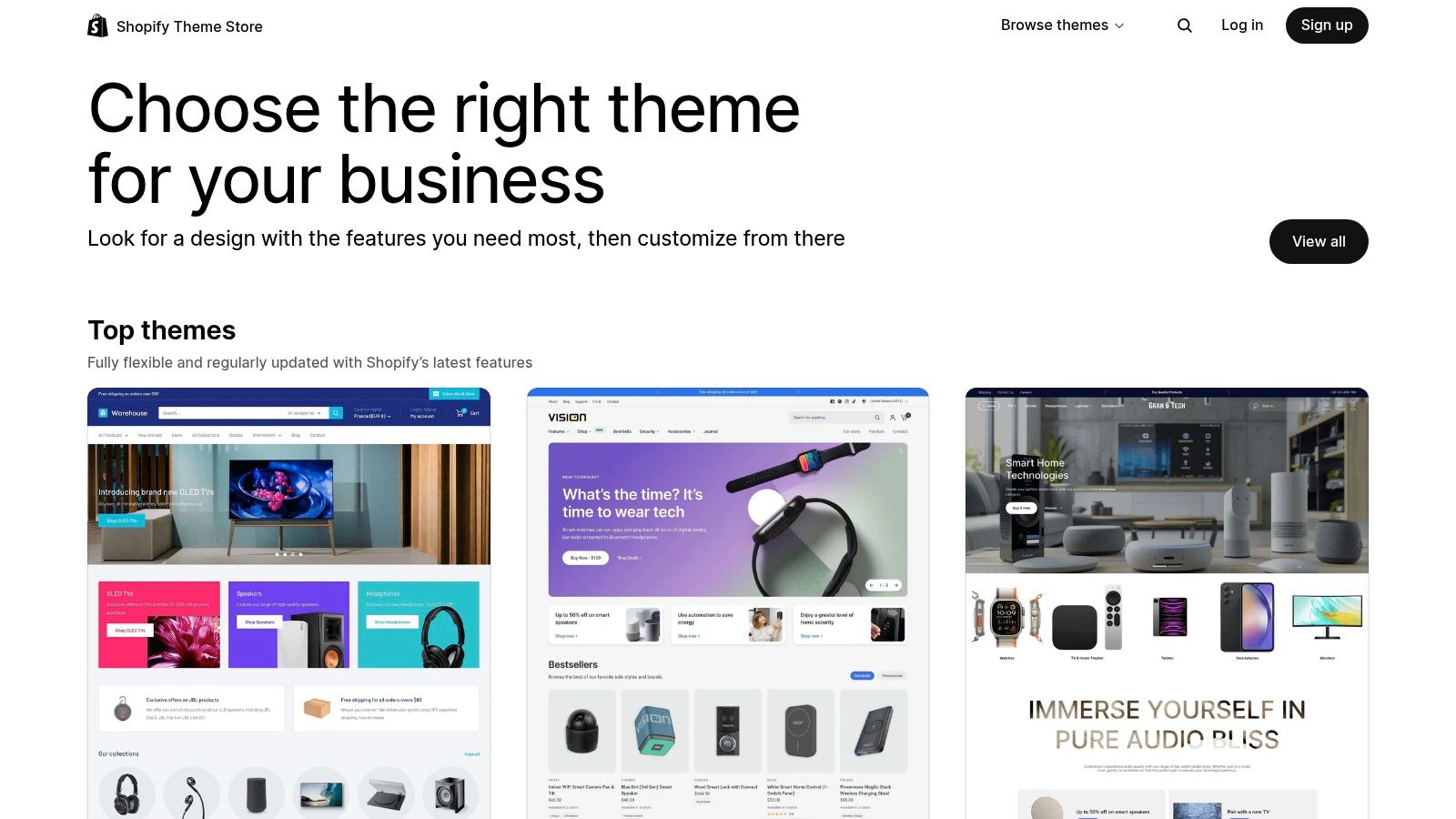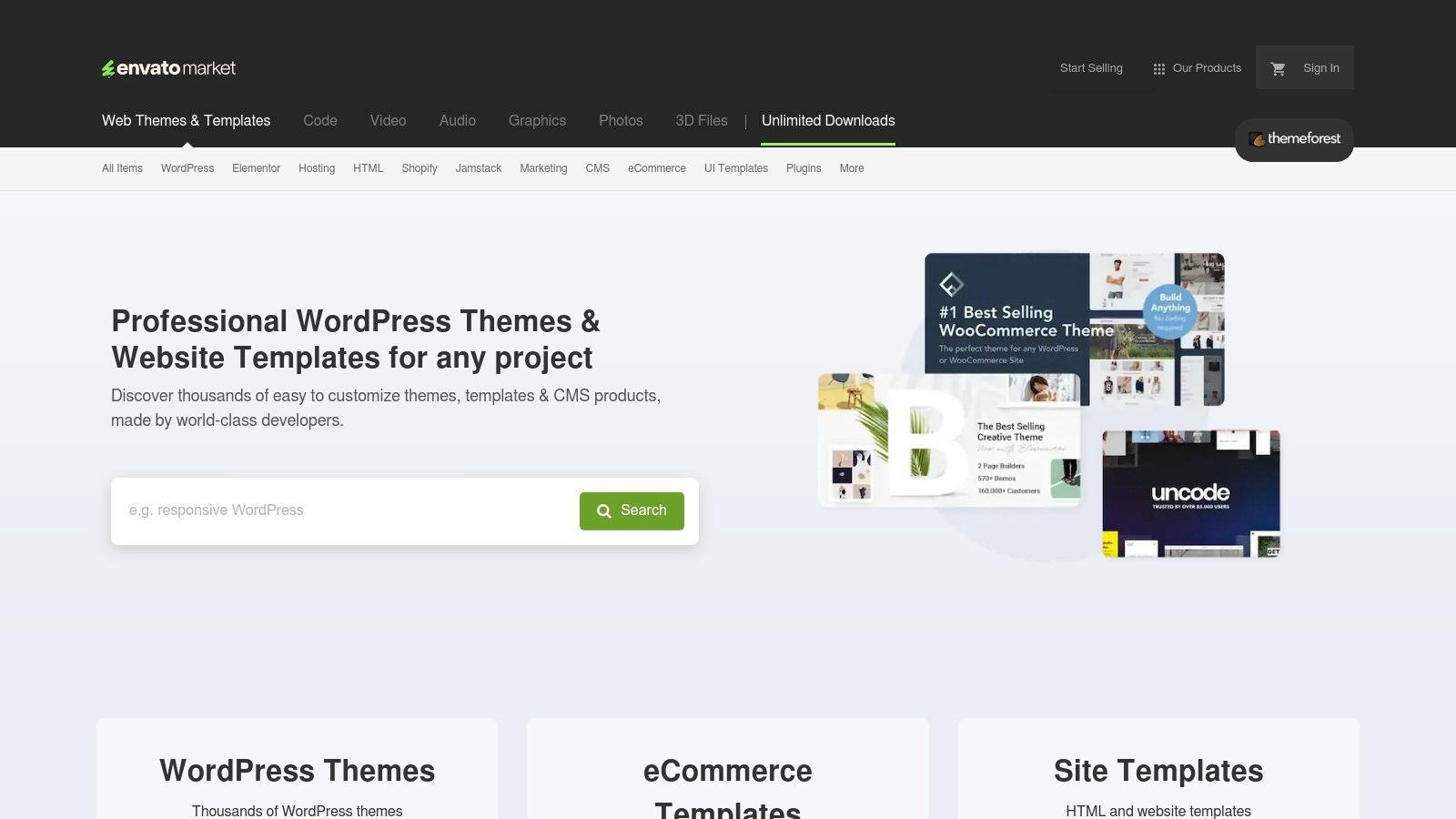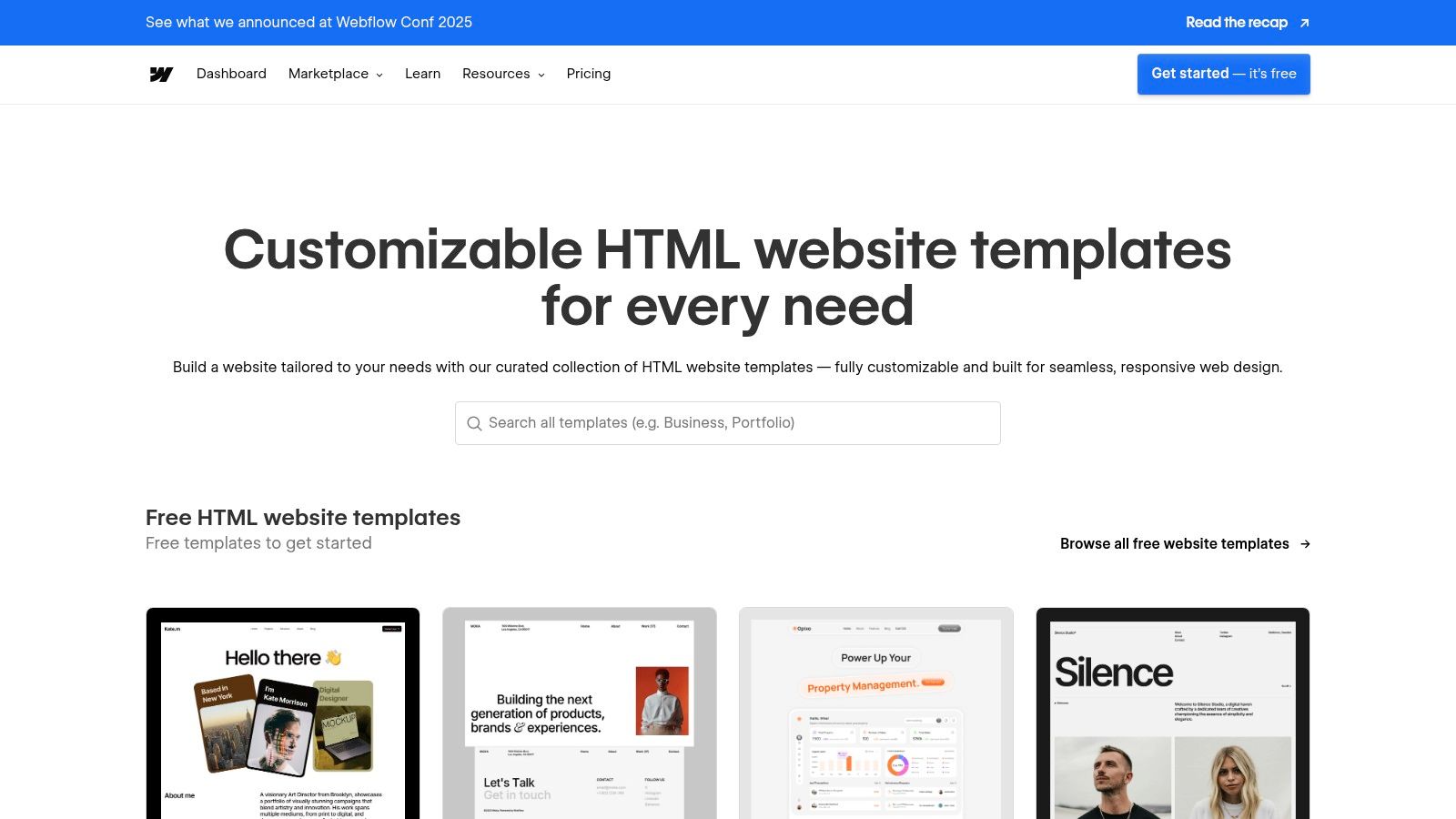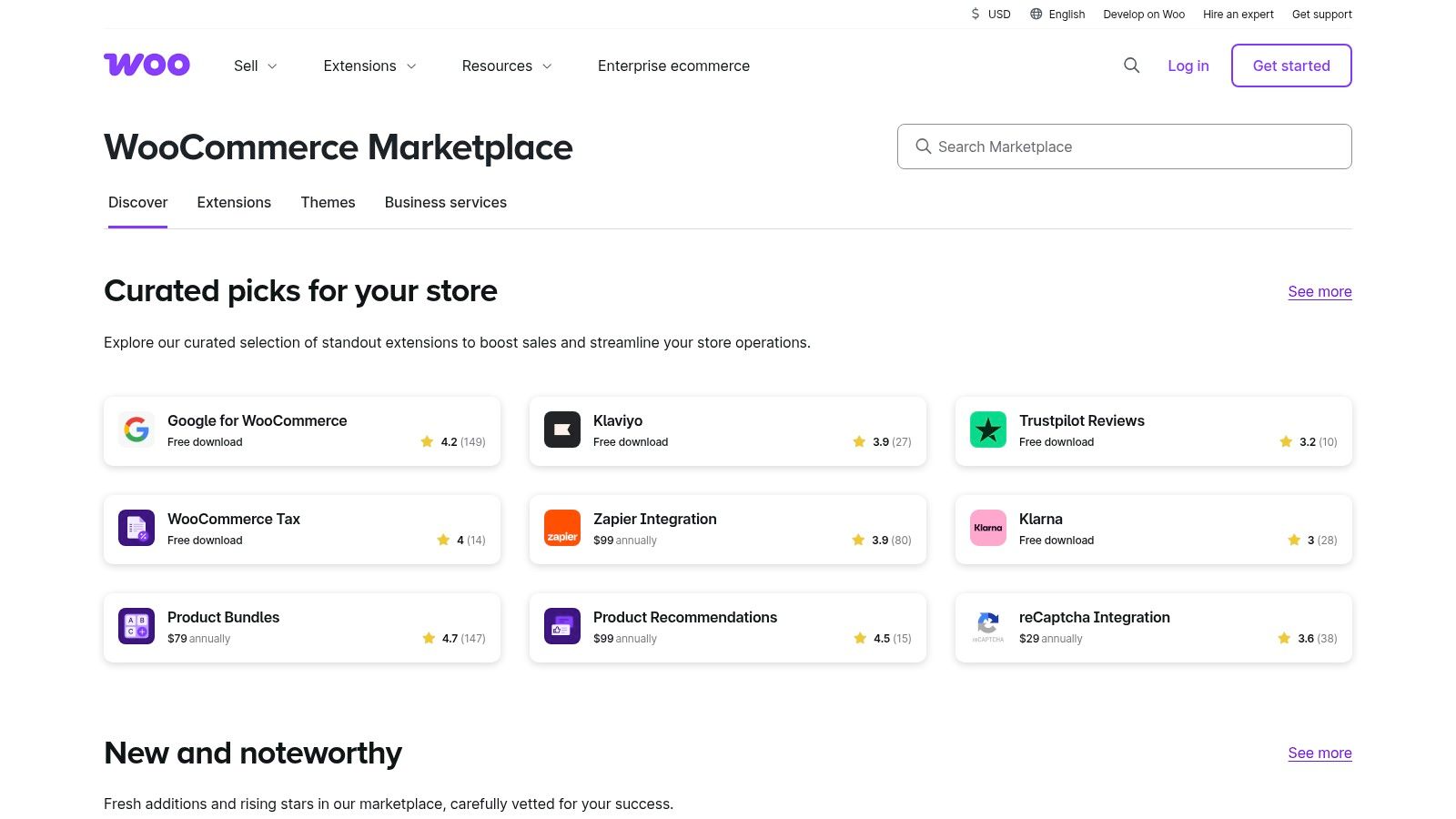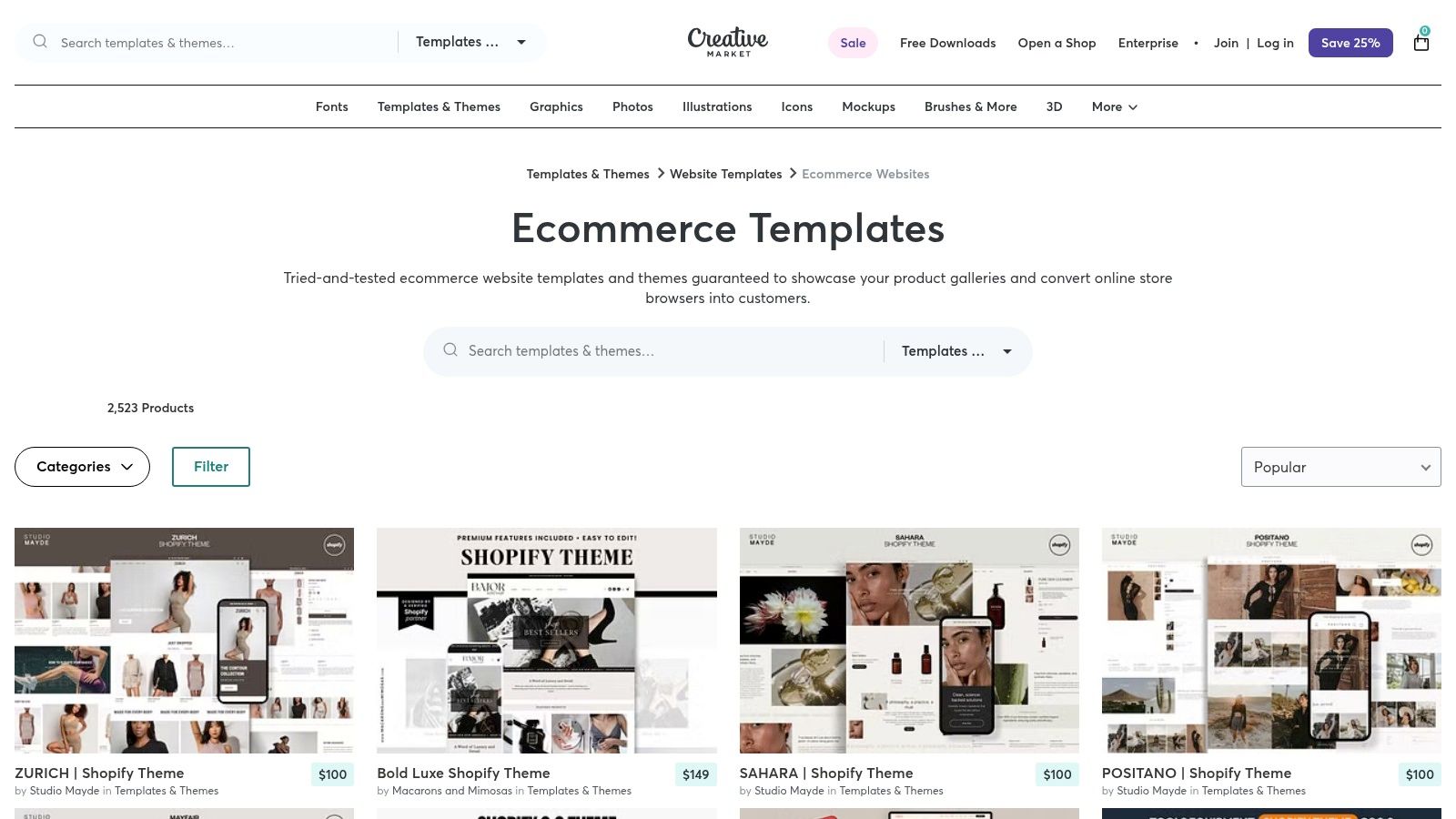In the crowded digital marketplace, a visually stunning website isn't enough. The best ecommerce website designs seamlessly blend aesthetics with an intuitive user experience, guiding visitors effortlessly from discovery to checkout. They build trust, tell a compelling brand story, and ultimately, make the act of shopping a genuine pleasure rather than a chore. This is the key to converting casual browsers into loyal, repeat customers.
This article moves beyond surface-level admiration. We will dissect 7 exceptional examples and resources, breaking down the specific strategic elements that power their success. Forget generic praise; we're focusing on replicable tactics you can apply directly to your own online store to boost conversions, enhance user engagement, and solidify your brand identity.
You'll discover the "why" behind their effective layouts, navigation, and conversion funnels. Each analysis includes annotated screenshots, direct links for further exploration, and actionable takeaways. Our goal is simple: to provide you with a practical blueprint for creating a high-performing e-commerce platform. Let's explore the designs that set the standard for online retail and uncover the secrets you can use to build your own success story.
1. Shopify Theme Store
For entrepreneurs building their online presence from the ground up, the Shopify Theme Store serves as an essential starting point and a goldmine of the best ecommerce website designs. It’s not just a marketplace; it’s a curated collection of high-performance, conversion-optimized storefronts designed to work seamlessly within the Shopify ecosystem. This official platform offers a streamlined process for finding, previewing, and implementing a design that aligns with your brand identity and business goals.
The store’s primary advantage is its guaranteed compatibility and stability. Each theme is rigorously vetted by Shopify to ensure it meets strict standards for speed, security, and mobile responsiveness. This eliminates the technical guesswork often associated with third-party designs, allowing merchants to focus on what matters: selling.
Strategic Analysis & Key Features
- Curated for Conversion: Themes are built with e-commerce best practices in mind, featuring intuitive navigation, clear calls-to-action, and optimized product pages.
- Powerful Filtering: Users can easily filter themes by industry (e.g., Fashion, Electronics), catalog size, layout style, and specific features like quick-buy buttons or slide-out carts. This precision saves countless hours of searching.
- Live Previews: The "View demo store" feature is a standout, allowing you to interact with a fully functional version of the theme before committing. This provides a true sense of the customer experience.
Before settling on a design, it's crucial to understand how your platform choice influences your options. The underlying technology of your store is foundational, so it’s wise to understand the key differences between Shopify and Bigcommerce as this will dictate your design flexibility.
Actionable Takeaways
When browsing the Shopify Theme Store, start by filtering for your specific industry and catalog size to narrow the options effectively. Prioritize themes that offer the features you need out-of-the-box to minimize reliance on third-party apps, which can slow down your site. While premium themes range from $180 to $350, the investment often pays for itself through superior performance and dedicated developer support. For those just starting, exploring the free themes is an excellent way to launch without initial design costs. For a deeper look, you can learn more about why Shopify is a top e-commerce platform for beginners.
2. ThemeForest (Envato Market)
For businesses seeking maximum choice across virtually any ecommerce platform, ThemeForest is the undisputed heavyweight champion. As the largest digital marketplace from Envato, it offers an unparalleled selection of ecommerce website designs for platforms like WooCommerce, Shopify, Magento, and more. This vast repository empowers developers and entrepreneurs to find highly specific, feature-rich themes outside of the official, often more limited, platform-specific stores.
The platform’s core strength lies in its sheer volume and competitive pricing, fostering an environment where niche designs and innovative features flourish. Each theme listing provides a wealth of information, including user ratings, sales data, detailed feature lists, and live demos, giving buyers the tools to make an informed decision. This transparency is crucial when navigating a marketplace with such a wide variance in quality and support.
Strategic Analysis & Key Features
- Platform Agnostic Selection: Unlike official stores, ThemeForest provides high-quality templates for nearly every major CMS, making it a one-stop-shop for agencies or businesses running multiple sites on different platforms.
- Data-Driven Vetting: Social proof is built directly into the interface. Buyers can easily see an item's sales count, user ratings, and last-update date, which are critical indicators of a theme's quality, popularity, and ongoing support from its developer.
- Feature-Rich Demos: Interactive live previews allow users to thoroughly test a theme’s front-end and, in many cases, its back-end admin panel. This provides a comprehensive understanding of the design and functionality before purchase.
Actionable Takeaways
When browsing ThemeForest, use the "Best sellers" and "Trending" filters to quickly identify popular and well-regarded options. Pay close attention to the comments and reviews section for each theme; this is where you will find honest user feedback about bugs, customization challenges, and the developer's support quality. Always check the theme's changelog to ensure it receives regular updates for security and compatibility. While prices are attractive (often $29-$79), prioritize themes from "Power Elite" authors, as they have a proven track record of quality and long-term support.
3. Webflow Templates (Ecommerce)
For businesses and designers who crave full creative control without writing code, the Webflow Ecommerce template marketplace is a premier destination. It moves beyond the traditional constraints of template-based systems, offering a visual canvas where designers can build sophisticated, custom shopping experiences. This platform is ideal for brands that want one of the best ecommerce website designs that truly stands out from the competition, blending powerful content management with robust ecommerce functionality.
Webflow’s core advantage lies in its no-code visual designer, which produces clean, semantic HTML and CSS. This means templates are not just visually stunning but also highly performant and SEO-friendly right out of the box. Users can start with a professionally designed template and customize every element, from micro-interactions to complex layout structures, ensuring brand consistency down to the last pixel.
Strategic Analysis & Key Features
- Unparalleled Design Flexibility: Unlike more rigid platforms, Webflow allows for direct manipulation of nearly every CSS property through its visual interface. This enables unique layouts and custom animations that are difficult to achieve elsewhere without a developer.
- Integrated CMS & Ecommerce: The platform seamlessly combines a powerful content management system with ecommerce tools. This is perfect for brands that rely on content marketing, allowing them to create rich product narratives and integrated blog posts.
- High-Fidelity Prototyping and Previews: Users can see exactly how their site will look and feel across different devices in real-time. This live design environment significantly speeds up the development and review process.
Actionable Takeaways
When exploring Webflow templates, focus on the underlying structure and layout rather than just colors and fonts, as these are easily changed. Use the "Live preview" feature to test animations and interactions to ensure they align with your brand's personality. While templates carry a one-time fee (typically $49-$129), you will need a Webflow ecommerce hosting plan, which starts at $29/month. To ease the learning curve, leverage Webflow University, an extensive free resource with video tutorials that can take you from novice to expert.
4. WooCommerce Marketplace
For businesses built on the world's most popular CMS, WordPress, the official WooCommerce Marketplace is the definitive hub for enhancing an online store. It functions less as a broad theme store and more as a specialized arsenal of extensions and select themes designed for perfect integration. This focus on compatibility makes it a crucial resource for merchants looking to add powerful, specific functionalities to their existing designs without risking technical conflicts.
The marketplace’s core strength lies in its quality assurance. Every product, from payment gateways to marketing tools, is vetted by the WooCommerce team, ensuring stability, security, and reliable support. This curated approach provides peace of mind, allowing store owners to confidently extend their site's capabilities and create some of the best ecommerce website designs through functional enhancements rather than just aesthetic changes.
Strategic Analysis & Key Features
- Guaranteed Compatibility: All extensions and themes clearly display version compatibility with both WordPress and WooCommerce, eliminating guesswork and preventing site-breaking updates.
- Vast Extension Library: The true power of the marketplace is its extensive collection of add-ons that enhance everything from product pages and checkout flows to shipping logic and subscriptions.
- Transparent and Secure Payments: Offers official integrations with WooPayments and other major third-party gateways, ensuring secure transaction processing. Beyond themes, ensuring smooth transactions is vital, and you can learn more about choosing the best payment gateway for your WooCommerce store.
- Developer-Backed Support: Most paid extensions come with dedicated developer support and a 30-day money-back guarantee, providing a safety net for your investment.
While the marketplace offers foundational themes, its real value is in functional customization. Merchants who need highly specific features often turn to custom e-commerce development to build upon a solid WooCommerce base.
Actionable Takeaways
When using the WooCommerce Marketplace, focus first on functionality, not just design. Identify the key features your store is missing, whether it’s advanced product filtering, a booking system, or a loyalty program, and search for extensions that meet those needs. While the official theme selection is limited, these extensions can transform a basic third-party theme into a high-performance sales machine. Be mindful that costs can add up quickly with multiple extensions, so create a budget and prioritize add-ons that will have the most significant impact on your conversion rates or operational efficiency.
5. Awwwards (E-commerce inspiration)
For designers, developers, and brand owners seeking to push creative boundaries, Awwwards serves as the ultimate gallery of the best ecommerce website designs. It is not a theme marketplace but a prestigious awards platform that curates and showcases the most innovative and aesthetically exceptional websites from around the globe. This makes it an unparalleled resource for inspiration, helping you discover cutting-edge UI/UX patterns and visual trends before they become mainstream.
The primary advantage of using Awwwards is its focus on award-winning quality. Every featured site has been vetted by a jury of leading design professionals, ensuring that you are only viewing top-tier examples. This saves countless hours of research by filtering out mediocre designs and presenting a high-quality collection of interactive, engaging, and effective e-commerce experiences that can inform your own projects.
Strategic Analysis & Key Features
- Curated for Innovation: Awwwards highlights websites that excel in creativity, user experience, and technical execution, offering a look into the future of e-commerce design.
- Component-Specific Filtering: Users can browse collections specifically focused on e-commerce elements like product pages, navigation menus, filters, and shopping carts. This allows for targeted research on specific parts of the user journey.
- Diverse Industry Inspiration: The platform features examples from countless industries and aesthetic styles, from minimalist fashion boutiques to highly interactive technology stores, providing a broad spectrum of creative ideas.
Understanding the principles behind these award-winning designs is key. A visually stunning site must also be functional and intuitive to drive sales, which is why it's crucial to learn more about why website design is important for your business's success.
Actionable Takeaways
Use Awwwards at the beginning of your design process to create mood boards and gather inspiration. Instead of looking at entire websites, filter by specific e-commerce components to find novel solutions for challenges like product discovery or checkout optimization. Pay close attention to how these sites use animation, micro-interactions, and unconventional layouts to create a memorable brand experience. While Awwwards is free to browse, a "Creative Pass" subscription offers access to courses and talks from industry leaders for those wanting to deepen their design knowledge.
6. SiteInspire (E-commerce design gallery)
For marketers, designers, and e-commerce entrepreneurs seeking a curated stream of high-caliber inspiration, SiteInspire stands out as a definitive resource. Unlike marketplaces focused on selling templates, this platform is a pure design gallery, showcasing some of the best ecommerce website designs from across the web. It operates as a powerful benchmarking tool, allowing you to survey the current aesthetic landscape and identify emerging UX patterns.
The platform’s strength lies in its meticulous curation and powerful, yet simple, filtering system. Every featured website is hand-picked for its exceptional design, creativity, and execution, ensuring a high-quality, noise-free browsing experience. This focus makes it an invaluable first stop for developing a mood board or defining the visual direction for a new e-commerce project.
Strategic Analysis & Key Features
- Granular Filtering System: SiteInspire allows users to filter its extensive gallery by type (e.g., E-commerce), style (e.g., Minimal, Typographic), and platform (e.g., Shopify, BigCommerce). This enables a highly targeted search for relevant design examples.
- Concise Site Profiles: Each entry provides a clean overview with high-resolution screenshots and a direct link to the live website. This facilitates a quick yet deep dive into the user experience and design choices of each example.
- Distraction-Free Interface: The minimalist UI is designed for one purpose: inspiration. It removes the clutter of ads or sales pitches, allowing you to focus entirely on the design aesthetics and functionality of the featured sites.
The platform is free to use, making it an accessible resource for businesses of all sizes, from solo entrepreneurs to enterprise-level design teams.
Actionable Takeaways
Use SiteInspire during the initial phases of your design process to establish a strong visual benchmark. Start by combining filters; for instance, search for "E-commerce" and "Minimal" to see how top brands are using clean aesthetics to drive sales. Pay close attention to navigation patterns, product page layouts, and mobile checkout flows on the live sites. While you cannot purchase themes here, you can gather a collection of examples to provide clear, effective direction to your web developer or design agency, ensuring your vision is executed precisely.
7. Creative Market (Ecommerce website templates)
For merchants and designers seeking unique, budget-friendly, and often highly stylized options, Creative Market stands out as a sprawling independent marketplace. Unlike official platform stores, it is a hub where thousands of individual creators sell their ecommerce website templates, UI kits, and theme assets. This model provides an unparalleled variety of design aesthetics, making it a go-to resource for brands wanting to break away from conventional layouts and find some of the best ecommerce website designs with a distinct creative flair.
The primary advantage of Creative Market is the sheer diversity and affordability it offers. Entrepreneurs can discover templates for major platforms like Shopify and WooCommerce or find UI kits for design software like Figma and Adobe XD. This flexibility serves both those looking for a ready-to-install theme and designers who prefer to build a custom storefront using pre-designed assets. It democratizes design by giving smaller businesses access to a vast creative pool.
Strategic Analysis & Key Features
- Immense Variety: The platform hosts a massive collection of templates from countless independent designers, resulting in a wide spectrum of visual styles that cater to niche markets.
- Granular Filtering: Users can effectively narrow their search by platform compatibility (e.g., Shopify, WooCommerce), file type, price range, and popularity. This makes navigating the extensive catalog much more manageable.
- Beyond Full Themes: A key differentiator is the availability of supplementary assets. You can find everything from UI kits and specific page section layouts to complete branding packages, allowing for a more modular approach to design.
Actionable Takeaways
When exploring Creative Market, pay close attention to seller ratings, customer reviews, and the date the item was last updated to ensure quality and compatibility. The documentation and support can vary significantly between creators, so carefully read the product description to understand what is included. Use the platform not just for complete themes but also to find individual assets like icon sets or banners that can enhance an existing design. Prices are often much lower than official theme stores, but be prepared to handle more of the technical setup yourself.
Top 7 Ecommerce Website Design Platforms Comparison
| Marketplace / Gallery | 🔄 Implementation Complexity | ⚡ Resource Requirements | 📊 Expected Outcomes | 💡 Ideal Use Cases | ⭐ Key Advantages |
|---|---|---|---|---|---|
| Shopify Theme Store | Medium – Ready-made, easy to preview & install | Moderate – Costs for premium themes + apps | Stable, secure, conversion-optimized storefronts | Store owners seeking reliable, integrated themes | Stable platform, app integrations, security |
| ThemeForest (Envato Market) | Medium-High – Requires vetting theme quality | Variable – Wide price range, budget options | Wide choice with competitive pricing | Buyers needing cross-platform variety | Huge selection, community reviews, pricing range |
| Webflow Templates (Ecommerce) | High – Visual design control with learning curve | Moderate-High – Hosting fees plus template cost | Highly customized, modern ecommerce sites | Users wanting design flexibility without coding | High customization, transparent pricing, education support |
| WooCommerce Marketplace | Medium – WordPress-based, compatibility focus | Moderate – Theme + extension costs can add up | Highly extendable WooCommerce stores | WordPress users requiring extensive extensions | Tight platform compatibility, strong extension ecosystem |
| Awwwards (E-commerce insp.) | Low – Inspiration only, no coding needed | Low – Free inspiration, optional paid courses | Access to cutting-edge ecommerce design concepts | Designers/developers seeking UI/UX ideas | Award-winning designs, saves research time |
| SiteInspire (Design gallery) | Low – Viewing and filtering inspirational sites | Low – Free and distraction-free browsing | Quick benchmarking of ecommerce aesthetics | Designers benchmarking ecommerce visual styles | Fast, easy browsing of curated ecommerce designs |
| Creative Market | Medium – Varies by template complexity | Low-Moderate – Affordable templates and assets | Diverse and affordable ecommerce designs | Budget-conscious buyers wanting variety | Affordable, diverse styles, design assets beyond themes |
Bringing Your Vision to Life: From Inspiration to Implementation
Throughout this exploration of the best ecommerce website designs, we've moved beyond simple aesthetics to uncover the strategic thinking that powers successful online stores. We've seen how platforms like Shopify and WooCommerce provide robust foundations, while marketplaces such as ThemeForest and Creative Market offer accessible, high-quality starting points for businesses of all sizes. For those seeking bespoke innovation, the curated examples on Awwwards and SiteInspire serve as a wellspring of creative inspiration, pushing the boundaries of what's possible in digital retail.
The common thread connecting every great design isn't a specific color palette or font choice; it's a relentless focus on the user. The most effective sites guide customers effortlessly from discovery to checkout, using intuitive navigation, compelling product storytelling, and a frictionless purchasing process. Your goal should be to internalize these principles, not just imitate the surface-level details.
Your Actionable Path Forward
Translating inspiration into a tangible, high-converting website requires a clear, strategic plan. As you embark on this process, focus on these critical steps:
- Define Your Core User Journey: Before looking at any template, map out the ideal path a customer takes on your site. What information do they need at each stage? What are their potential pain points? A clear user journey map is your most valuable design tool.
- Select Your Platform Wisely: Your choice of tool will define your capabilities. If you need an all-in-one, user-friendly solution, Shopify is a strong contender. If you prioritize flexibility and own your data on a WordPress site, WooCommerce is the answer. For unparalleled design control without deep coding knowledge, Webflow offers a powerful visual development environment.
- Prioritize Performance and Accessibility: A beautiful design is useless if it's slow to load or difficult for users with disabilities to navigate. Always optimize your images, choose a reliable hosting provider, and follow web accessibility (WCAG) guidelines. This not only creates a better experience but also positively impacts your SEO.
- Test, Iterate, and Optimize: The launch of your website is just the beginning. Use analytics and user feedback to understand how people are interacting with your store. Identify drop-off points in your funnel and continuously test changes to improve conversion rates.
Final Thoughts on Building Your E-commerce Powerhouse
Ultimately, the best ecommerce website designs are those that function as powerful business assets, seamlessly blending brand identity with commercial objectives. They build trust through professional presentation, reduce friction with smart UX, and create memorable experiences that turn one-time buyers into loyal brand advocates.
Whether you choose a pre-built theme as a launchpad or invest in a custom-built experience, the foundational strategies remain the same. Focus on clarity, build for your specific audience, and never stop refining the customer journey. By applying these lessons, you can transform your e-commerce vision into a reality that not only looks exceptional but also delivers measurable results.
Studying the best ecommerce website designs is the perfect starting point, but turning that inspiration into a high-performing reality is the next critical step. If you're ready to build an online store that not only looks incredible but also drives measurable growth, the experts at Sugar Pixels are here to help. We translate cutting-edge design principles into powerful, custom e-commerce solutions that convert.
